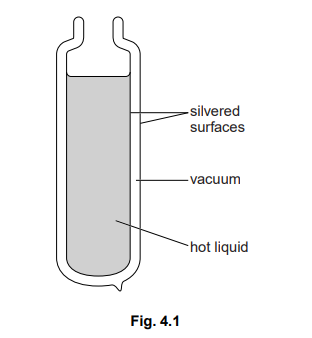Question
Fig. 4.1 shows a cross-section of a double-walled glass vacuum flask, containing a hot liquid.
The surfaces of the two glass walls of the flask have shiny silvered coatings.
(a) Explain
(i) why the rate of loss of thermal energy through the walls of the flask by conduction is very low,
(ii) why the rate of loss of thermal energy through the walls of the flask by radiation is very low.
(b) Suggest, with reasons, what must be added to the flask shown in Fig. 4.1 in order to keep the liquid hot.
Answer/Explanation
Answer:
(a) (i) mention of vacuum OR glass is a poor conductor OR vacuum/gap between walls has no molecules/atoms/particles
(ii) surface/silver (of walls) is good reflector/poor absorber (of radiation) surface/silver (of walls) is poor emitter (of radiation)
(b) add a stopper/lid/bung/cover/top to reduce/prevent (loss of heat by) convection/ conduction/radiation/evaporation OR to prevent steam/hot vapour leaving made of insulator OR example of insulator to reduce/prevent (loss of heat by) convection/radiation/evaporation OR to prevent steam/hot air leaving
Question
One side of a copper sheet is highly polished and the other side is painted matt black.
The copper sheet is very hot and placed in a vertical position, as \shown as in Fig. 5.1.

A student places her hands at equal distances from the sheet, as shown in Fig 5.1
(a) Explain
(i) why her hands are not heated by convection,
(ii) why her hands are not heated by conduction.
(b) State and explain which hand gets hotter.
(c) It is suggested that one side of the copper sheet cools to a lower temperature than the
other side.
Explain why this does not happen.
Answer/Explanation
Answer:
(a) (i) heated air/warm air rises/moves up (not sideways)
(ii) air (between plate and hands) is a poor conductor/does not conduct
(b) left hand/palm (facing matt black side gets hotter)
OR hand facing matt black side (gets hotter)
matt black side is a better emitter/radiator (of heat than shiny side)
(c) conduction takes place
copper a good conductor/ conduction is rapid/heat flows to equalise temperature

